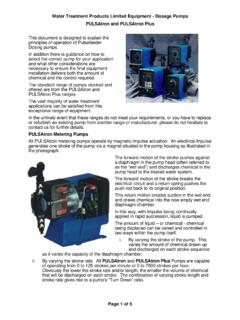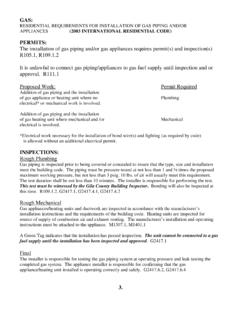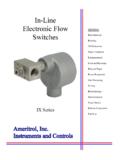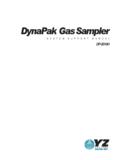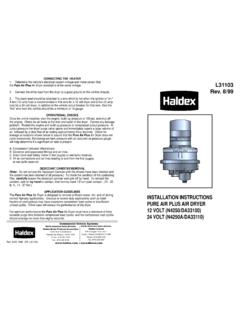Transcription of Dosage Pump Installation Guide - Water Treatment Products
1 And Dosage pumps - Installation Guide To be read in conjunction with schematics on pages 4, 5 and 6. Location The metering pump should be located in an area that allows convenient access to both the chemical storage tank and the point of injection. The pump is Water resistant and dust proof by construction and can be used outdoors. However, it should be protected from driving rain and freezing conditions. Avoid continuous temperatures in excess of 40 C. To do otherwise could result in damage to the pump. Mounting Chemical storage tanks should always be bunded to ensure any chemical waste resulting from spills, leakage or tank failure is contained safely and effectively. Typical mounting arrangements are shown in Figures 1 to 3. All pumps are supplied with three lengths of tubing for suction delivery and bleed valve return purposes. It is important to ensure the correct tubing is used for each application.
2 The standard tubing supplied with each pump is normally 1 metre of clear flexible PVC tubing for the bleed line return. 1 metre of stiff white polyethylene tubing for the suction line. 2 metres of stiff white polyethylene tubing for the discharge line. Note; Longer lengths of tubing are available as optional extras. Suction/Discharge tubing may vary for some chemicals and/or high pressure pumps . Some high volume output pumps do not have a three way bleed valve. All pump bases have 4 lugs with holes to secure the pump to the mounting surface. Suitable fixings must be used which are resistant to attack from the chemical(s) in use. These fixings are not part of the standard pump supply. Wall or Shelf Mounting Purpose made wall brackets are available in plastic or stainless steel as an optional extra. Refer to Figure 1. Connect suction tubing to suction (lower) valve of chemical pump.
3 tubing should be long enough so that the foot valve/strainer assembly hangs about - 5 cm above the bottom of chemical tank. It is important to ensure that the ceramic weight is installed to keep the suction tubing from coiling up in the chemical tank. To keep chemical from being contaminated, the tank should have a cover. Flooded Suction Mounting In this mode the pump is installed at the base of the chemical storage tank, see Figure 2. This method of Installation requires a suitable stand for the chemical storage tank with a platform to mount the pump. Flooded suction mounting can overcome problems experienced with very low output or infrequent use applications which may suffer from loss of prime in suction lift mode. Flooded suction can also overcome gassing experienced with the Dosage of oxidising chemicals such as chlorine. The connection to the tank must be leak free.
4 If it is to the side of the tank it should be - 5 cm above the base. If the connection is to the base of the tank an up stand of - 5 cm should be employed to ensure no accumulation of precipitants enters the suction line. A method of isolating the suction line should be employed to facilitate pump maintenance. Tank Mounting This is the most common method employed as illustrated in Figure 3. The exact position for location of the pump on the tank will depend on the type of tank in use. However, a flat surface slightly larger than the pump foot print must be available. Secure the pump by drilling four x mm diameter holes and fix using four nuts, washers and bolts suitably resistant to the chemical(s) in use. Two holes must be drilled in the top of the tank to accommodate the suction and bleed return lines. Insert suction tubing through the relevant hole and cut so that the foot valve/strainer hangs about - 5 cm above the bottom of the tank.
5 Anti-Siphoning Siphoning of chemical can occur when The injection point is on the suction side of a system circulation point The injection point is below the level of chemical in the storage tank If conditions such as these can not be avoided USE AN ANTI-SIPHON VALVE IN THE DISCHARGE LINE whenever the fluid pressure in the discharge line. In addition, the chemical injection valve supplied as standard must always be fitted to the end of the discharge line. The fitting must be used even if chemical discharge is into an open sump. tubing Use the tubing provided of specified size for connection. If longer lengths of tubing are required ensure that the specification and size is suitable for the application. Connect tubing securely to prevent leakage of chemical and the entrance of air. Since plastic nuts are used for fittings, they should not be tightened excessively, hand tighten only.
6 Suction and discharge valves must NOT be over tightened or subjected to undue strain during Installation or final use. Tighten to to kg/cm. If the air bleed valve assembly is being used, return line tubing should be securely connected and routed back to the storage tank. To avoid possible injury from chemicals do not attempt to prime using a bleed valve without installing a return line. To maintain metering performance, a backpressure/injection valve is provided. The injection valve must be installed in the discharge line at the point of chemical injection. If the discharge tubing is going to be exposed to direct sunlight, black tubing should be used instead of the standard white translucent tubing supplied with each pump. This is particularly important if the chemical being dosed is an oxidising chemical such as chlorine based. To prevent clogging or check valve malfunction always install a strainer assembly to the end of the suction tubing .
7 The foot valve/strainer assembly should always be installed - 5 cm above the bottom of the chemical tank. This will help prevent clogging the strainer with any solids that may settle on the tank bottom. The chemical tank and foot valve/strainer should be cleaned regularly, to ensure continuous trouble free operation. Flooded suction mode can be beneficial in overcoming gassing problems associated with the use of oxidising chemicals such as chlorine based chemicals. Gassing is the formation of small air bubbles in the Dosage lines and pump head which result in loss of prime or poor pumping performance. Maintaining a low liquid temperature and using black storage tanks and Dosage lines will also be of benefit. 5-way degas valves and degas pump heads are also available to eliminate gassing problems. Publication WTP/Ptron/IG/08/04 Dosage Injection Points Localised corrosion can sometimes occur at the point of chemical injection if dilution at the injection point does not occur rapidly.
8 To prevent this occurring, the injection fitting should be installed so that the end is in the centre of the flow stream of the line being treated as shown in the diagram. Trim injector tip as required. Avoid installing injection points whereby the injection fitting cannot be removed unless system is drained down. Water Meter Some pumps will be activated by an impulse Water meter. If a Water meter is part of the supply, always install it with a by pass line as shown in the schematic. Water meters should be sized to make up flow only. Never fill the system via the Water meter as damage to the Water meter can result. To ensure correct operation and accuracy, install Water meters horizontally with meter face up and in an easily read position. A horizontal length equivalent to at least 12 pipe diameters must precede the Water meter inlet and a horizontal pipe length of 6 diameters must follow it. PULSA tron Plus pumps Dependant on the model employed, PULSA tron Plus pumps will require the Installation of ancillary items Flow Assembly The standard flow assembly is constructed of durable glass filled polypropylene (GFPPL).
9 Connection to the flow line is NPT. Two PVC thread to slip adapters are provided to facilitate welded joints as an option. Install the flow assembly at a location prior to chemical injection points. The probe electrodes must be continuously immersed in system Water at all times and must not be allowed to dry out particularly when the treated Water system is off line. A pressure differential must exist across the flow assembly sufficient to provide a flow rate of 5 to 20 litres/minute through the assembly to activate the flow switch at all times. It is good practice to install a strainer before the flow assembly to collect debris that might affect pump operation. If the treated Water is high in suspended solids consider additional filtration to prevent probe fouling and malfunction occurring. Install unions and isolating valves on both the inlet and outlet to facilitate routine maintenance.
10 Direction of flow must be from the bottom to the top of the flow assembly to operate the flow-monitoring switch correctly. Solenoid Valve An isolation valve and strainer should be installed prior to the solenoid valve in the blowdown line to enable maintenance of the solenoid valve to be carried out. Electrical All electrical connections should be undertaken in accordance with local regulations by a suitably qualified engineer. The electrical supply to the pump will depend on the method of operation. However, the supply should always conform to the specification on the pump name plate. Applying higher voltage than the pump is rated for will damage the internal circuit. Dependant on the model of pump, fuse protection is integral with the standard pump. However, it is recommended that regardless of the source of the pump activation, the final supply to the Dosage pump should be via a separate 13-amp isolator fused to 3 amps.


